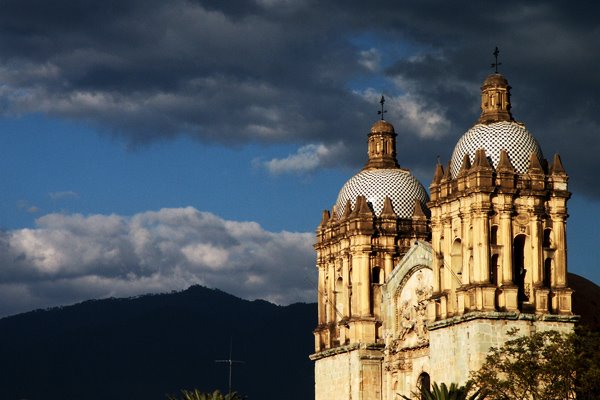from Tim Johnson at McClatchey (emphasis added)
For a week now, striking teachers have brought much of Mexico’s capital to a crawl with traffic-snarling protests, and the unrest looks likely to expand in coming days to capture discontent far beyond mandatory teacher evaluations.
The unrest is offering a major challenge to President Enrique Pena Nieto’s drive not only to improve schools but also to boost Mexico’s economic growth rate by restructuring the state energy sector and the way Mexicans are taxed.
For the past week, tens of thousands of striking teachers have converged on – and disrupted life in – Mexico City.
Most of the teachers have thronged to Mexico City from the outlying states of Michoacan and Oaxaca, though more are expected from other states.
Strikers Tuesday swarmed outside the installations of Televisa, the media conglomerate, a day after they shut down the capital’s main boulevard. Last week, teachers – some of them smashing windows or tearing down fencing – blocked sessions of the two chambers of Congress, forcing legislators to convene across the city in a convention center, and hindered access to the international airport.
Squads of riot police have not moved against the protesters even though 29 police suffered injuries last week. Analysts said a police allergy to confrontation has emboldened striking teachers, increasing chances of greater violence.
“There is a strong sense that this group is trying to figure out a way where they could have a martyr,” said Ana Maria Salazar, a political analyst and television commentator.
In one of his first achievements as president, Pena Nieto in February enacted a sweeping education reform that sailed through Congress. Legislators last week took up secondary legislation, passing two laws but not a critical third one that would mandate teacher evaluations and regulate hiring and firing.
“If you don’t pass on your second evaluation, you lose your job. How is this possible?” asked Vicenta Velazquez Reyes, a striking teacher from Zitacuaro in Michoacan state who led an encampment of strikers outside the Senate.
Pena Nieto and Congress have a packed political agenda in coming weeks. The president offers his first state of the nation speech Sept. 1, and a week later will present a fiscal reform that is rumored to contain taxation on some foods and medicines, a move not likely to find many champions.
A two-time leftist presidential candidate, Andres Manuel Lopez Obrador, has convoked a massive Sept. 8 rally for opponents of a sweeping proposal announced earlier this month to open up Mexico’s oil industry to foreign investment.
“The next couple of weeks, two or three weeks, could potentially be very, very difficult in terms of mobilizations here in Mexico City,” Salazar said.
Pena Nieto vows not to back down. “We are clear that all change invariably will bring resistance,” he said Monday.
Especially in outlying states, Mexico’s teachers are seen as a voice for the poor even as their national union – at one time the largest in Latin America – became a formidable political force and a bastion of corruption.
Pena Nieto’s government arrested the teachers union boss, Elba Esther Gordillo, in late February on corruption charges. She remains in jail.
Even as leftist sectors applaud the opposition to some of Pena Nieto’s proposals, the road blockages and snarled traffic in the capital have exasperated many citizens and business owners.
Some 16,000 stores, restaurants, hotels and other businesses in central Mexico City have been harmed in the past week, seeing business fall by as much as 87 percent, says the Mexico City Chamber of Commerce, Services and Tourism.
“What are we asking for? That police clear the streets so that we can transit them,” said Gerardo Lopez Becerra, the chamber’s president. “It’s not repression we are asking for. It’s the exercising of authority.”
The main plaza of Mexico City, known as the Zocalo, is now a sea of colorful nylon tarps and tents, taken over by striking teachers, who are nearly all from outside the capital.
A poll published Monday by the El Universal newspaper said 82 percent of city residents do not believe authorities should permit marches that block roads.
Pressure is growing on Mexico City Mayor Miguel Mancera to limit disruptions. A prominent member of the leftist Party of the Democratic Revolution, Mancera does not want to antagonize his party’s grassroots base, even if that means that the metropolitan area’s more than 20 million residents are inconvenienced.
“I reiterate that we will protect the physical integrity of the citizens, of their belongings,” Mancera said Tuesday, as he acknowledged that “we know there is a convocation so that more people come” to protests in the capital.
While the teachers protest in Mexico’s capital, some 2 million of Mexico’s 26 million or so public school students are unable to attend classes.
Some Mexicans believe hidden forces are behind the unrest, seeking to derail Pena Nieto’s proposals for lessening the power of the national teachers union, opening up of the state oil sector to foreign investment and increasing taxes.
“Who is paying for the hundreds of buses that the protesters use to move about? Who is paying for their meals?” wrote Luis Apperti, a columnist for Milenio newspaper.
Mexico has the lowest tax collection rate of all 34 countries in the Organization for Economic Cooperation and Development, a forum of democracies with developed market economies. Mexico collected 9.8 percent of its of economic output in taxes in 2012.


No comments:
Post a Comment